


|
Echophone Commercial EC-1 (1941)
[UPDATED]
When first appeared in early 1941 with its sensational $19.95 price tag,
EC-1 was a general purpose shortwave receiver everyone could afford. In late 1941,
EC-1 advertisement on QST changed to the famous "Hoggarth" series;
EC-1 started to serve as military entertainment.
Then on the next month, a word "National Emergency" was replaced by a word "War".
The unit here had suffered severe hum in the AM detector output. Almost all of the compoments in the vicinity of IF amp and detector stage were cut once, then reconnected by solder. It seems the previous owner tried to troubleshoot it, and most likely, he could not discover the root cause - an interelectrode short between the cathode and the heater inside of the 12SK7 IF amplifier tube. |
|

|
Echophone Commercial EC-1A (1946)
[UPDATED]
Hallicrafters did not name its own brand to this low-priced 6 tubes set,
being afraid of its reputation degraded with marginal performance.
In the reality the radio worked pretty well,
and its basic design led the way to the famous S-38 series.
The EC-1A here had metalic blue repainting when acquired, and was repainted again to bright ivory.
|
|

|
Echophone Commercial EC-1B (1946)
The first peacetime production of EC-1A was soon replaced with EC-1B,
although there was no announcement or advertisement made on the QST magazine.
Its bandspread is done by moving oscillator coil core,
rather than the combined tuning capacitor.
The EC-1B soon got facelift as Hallicrafters S-41G/W,
resulted in very short production period of just a few months.
|
|

|
Hallicrafters S-41G "Skyrider Jr." (1946)
[UPDATED]
Boys knew that the Echophone EC-1A/B was designed and manufactured by Hallicrafters, and of course,
they wanted the Hallicrafters logo on their radio.
The company answered to such voices by introducing the S-41G/W "Skyrider Jr."
which is identical to EC-1B except its color and the Hallicrafters logo.
The gray version S-41G here plays very well, although no apparent maintenance was given for these 50 years.
|
|

|
Hallicrafters S-38C (1953)
[UPDATED]
Although it's just a mere 5 tubes single superhet,
its admirable performance,
appealing style and affordable price guided many youngsters into the world of wireless communication and electronics.
Some Japanese manufactures copied its unique design.
The unit here was in a poor condition both in electrical and cosmetical. More than 20 years after purchased at a classic car swapmeet in Livermore, the radio serviced to a nice performer. |
|

|
Hallicrafters S-20R "Sky Champion" (1939)
[UPDATED]
This popular midrange prewar model employs a 6K8 frequency converter tube which electrode arrangement is quite unique.
The receiver configuration is almost equivalent to the Japanese models in early 1960s such as famous Trio 9R-59,
it will be interesting to play side by side with them.
General service bring the radio vivid. The aged, dark amber colored dial disks were replaced with handmade ones, now with the calibrated bandspread scale. |
|

|
Hallicrafters SX-96 (1955)
[UPDATED]
Loaded with complete double superhet and dedicated USB/LSB position,
this neat general coverage receiver provides smooth tuning,
sharp selectivity and stable operation for amateur communication.
The unit here had suffered distorted AM audio,
cured by altering the component values used in the detector circuit.
|
|

|
National NC-57B (1947)
[UPDATED]
|
|

|
Lafayette HA-55A Aircraft Receiver (circa 1964)
Compact vacuum tube airband receiver uses a Nuvistor as its RF amplifier.
Circuit was modified by someone so that it could use 12AT7 instead of 6AQ8.
Severe image interference may be attributed to this modification.
|
|

|
Lafayette HA-63A (1966)
[UPDATED]
This clean 1-RF 1-IF single superhet showed miserable performance when it arrived at our lab,
although the receiver had been recapped by the previous owner.
By using a brand new signal generator with frequency counter deployed to the lab,
circuit alignment was performed which made the radio vivid and strong.
|
|

|
Lafayette HA-230 (1964)
An export version of famous Japanese Trio 9R-59.
A dusty, broken, only-to-buzz unit was restored to a clean performer.
Strange AGC action was cured by replacing an AGC filter cap and a 6BA6 which suffered a grid emission.
It has a band spread dial calibrated to the amateur bands, but receiving SSB is far from ideal.
|
|

|
Lafayette HE-80 (1964)
[UPDATED]
An export version of the Trio JR-60, an upgraded 9R-59.
This single superhet has 14 tubes, including product detector, voltage regulator and 6m crystal converter.
Recapping revived crisp audio,
and the very poor sensitivity was found to be caused by the IFT misalignment possibly done by an inexperienced user.
|
|

|
Lafayette HA-225 (1964)
[UPDATED]
The HA-225 appeared on U.S market in 1964 earlier than the HE-80 which original introduction plan was somehow delayed.
HA-225 and HE-80 are quite similar.
HA-225 covers longwave instead of medium wave band, and the FM reception mode is omitted.
In addition, it has many minor design changes internally,
therefore HA-225 may be called an improved version of HE-80.
|
|

|
Allied A-2515A (1970)
[UPDATED]
Legendary Trio 9R-59 certainly flowered the popularity of amateur radio in Japan.
It had, however, some shortcomings as a SSB receiver.
How it would look like, if it was fully improved with solid state technology?
The answer was the Allied A-2515A.
|
|
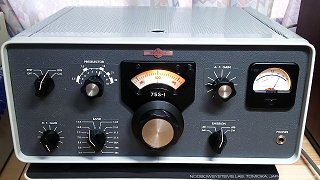
|
Collins 75S-1 (1958)
[UPDATED]
This 10 tubes receiver set a new standard of amateur radio equipments.
So called "Collins Type" double superheterodyne and a mechanical filter,
effective and carefully designed circuit.
The unit here had suffered a bad SSB reception, possibly due to the capacitor leakage in the product detector.
Amazingly it healed by itself!
|
|

|
Collins 51S-1 (1958)
[UPDATED]
Clean professional look and military quality,
this rock solid receiver with 1kHz readout capability is certainly one of the best general coverage shortwave receivers ever produced.
Missing case and wrong dial knob was the reason of the price of this unit lower than average,
but this dream receiver is working prominently just as the emblem promises.
|
|

|
Hammerlund HQ-170 (1959)
This big receiver certainly has a flavor of the BoatAnchors.
Triple superhet, total of 5 IF amplifier stages,
and panel full of controls allow the user to adjust all the characteristics of the receiver.
One of the IFTs of this unit burnt during the service,
but was able to be fixed.
Frequency drift is still annoyance, more effort should be paid.
|
|

|
National (Matsushita) CRV-1 Shortwave Receiver Kit (1960)
Sold in kit form somewhat resembles to the National NC-173.
Configuration is 1-RF 2-IF single superhet,
and almost identical to the Trio 9R-59. CRV-1 somehow did not sell well,
but many JAs recall it was much stable than Trio. The unit is being serviced now.
|
|

|
CRV-1/HB Homebrew Shortwave Communications Receiver (1960)
[UPDATED]
Matsushita Electric produced high quality components
(such as tuning caps and coil packs) for amateurs.
Data sheets of those parts showed an example how to build a shortwave receiver with them.
The receiver here was built based on it.
Since the data sheet example later became the CRV-1, I named this homebrew as CRV-1/HB.
|
|

|
Heathkit GR-64 Shortwave Commubnications Receiver Kit (1964)
[UPDATED]
This 4 tubes kit was a cheap buy at a hamfest, showed very poor performance in all aspects.
Changing some of the component values from the original design was necessary.
Poorly designed dial mechanism prevented smooth tuning.
This radio was indeed a great educational kit as I had to study a lot of radio engineering textbooks until I could finally fix it.
|
|

|
Sideband Engineers SB-33 Bilateral HF SSB Transceiver (1963)
Founded by Faust Gonset,
SBE produced this ambitious compact SSB transceiver for mobile use.
Transistorized except final power stage, Collins mechanical filter,and unique bilateral circuit design.
SB-33 is called the world's first practical transistorized amateur radio transceiver.
|
|

|
Sideband Engineers SB-34 Bilateral HF SSB Transceiver (1966)
Basic concept is kept,
SB-34 was the refined and improved model of the SB-33.
Now the DC12V inverter power supply is built-in, and the panel design is much sharp than its predecessor.
In the lab two of this undervalued equipment are waiting back on the air.
|
|
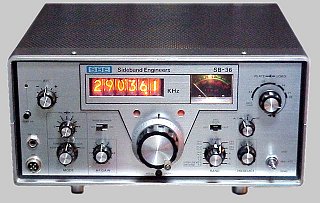
|
Linear Systems SBE SB-36 HF SSB Transceiver (1972)
After the short lived SB-35, SBE decided to name an imported Japanese model as SB-36.
This innovative digital readout HF transceiver has a hybrid construction,
using some vacuum tubes in signal path as well as the final amplifier which accepts 500watts of input power.
|
|

|
Yaesu FR-50 Amateur Band Receiver (1966)
I was hesitating to tweak vacuum tube equipments after 3-11; conserving energy was more important.
Now it should not be felt so guilty, if on weekends and avoiding the peak time of power consumption.
A new face to the lab is the early production of Yaesu FR-50 receiver.
The previous owner told me that he serviced the receiver by himself and it was fully operational.
I hoped it was not fully true, and the initial test found that the S meter was not working and the SSB audio was not perfect.
It was the beginning of another fun time.
|
|

|
Yaesu FT-620 50MHz SSB Transceiver (1972) |
|

|
Yaesu FT-620B 50MHz SSB Transceiver |
|
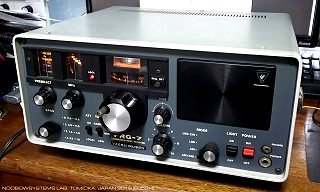
|
Yaesu FRG-7 General Coverage Communications Receiver (1976)
[UPDATED]
|
|
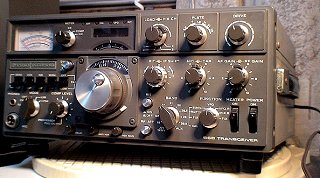
|
Trio (Kenwood) TS-820S HF SSB Transceiver
[UPDATED]
My first attempt to get on the HF with brand new TS-820X failed because I cound not prepare a proper antenna.
Realizing the lack of the skill, knowledge, experience and budget, defeated,
I sold the radio to a local station.
So ended the 1st season of my amateur radio life.
30 years later, I decided to try again.
The unit here was obtained at a hamfest.
It worked fine except unstable digital readout,
until its main fuse blew with large slap sound.
My true rechallenge had begun.
|
|

|
Trio (Kenwood) TS-600 50MHz All Mode Transceiver
Full solid state 6m all mode transceiver with its stylish appearance was on the top of 6 meter equipments when I got my license.
My desire to use this radio didn't go away for 27 years and finally it arrived at my lab.
|
|

|
ICOM IC-71 50MHz AM Transceiver (1970)
This early ICOM 50MHz AM/FM desktop transceiver instantly back to life 52 years after its production.
VFO stability is quite good - perhaps better than Collins 70K-2 PTO,
showing the Japan's catchup engineering effort (still 12years behind, though).
Although in good working condition, it does not have the optional calibrator/BFO unit,
making the equipment no practical use other than monitoring the static.
Building an BFO unit for this transceiver will be a fun challenge.
|
|

|
Sony ICF-1100D "The 11 D" 3 Band Portable Receiver
[NEW]
|
|

|
Sony ICF-5500 "Skysensor 5500" Shortwave Receiver
[UPDATED]
Although the shortwave was not the priority for the 5500,
this portable receiver defined the basic flavor of legendary Sony SkySensor series.
Once disassembled, you'll enjoy solving a puzzle - well, it's a Sony.
No electronic service was required for this unit, but the sluggish dial mechanism should be fixed someday.
|
|

|
Sony ICF-5800 "Skysensor 5800" Shortwave Receiver
[UPDATED]
Clearly aiming the shortwave listening, the SkySensor 5800 fueled the shortwave boom in Japan back in 1970s.
Its cool professional like styling, double speed reduction tuning with moving-film dial,
covering up to 30MHz and a BFO; all gave the thrill of the shortwave.
The unit had suffered distorted audio and sluggish dial, which were cured after the servicing.
|
|

|
Sony ICF-5900W "Skysensor 5900" Shortwave Receiver
[UPDATED]
The masterpiece of Japanese portable in middle 1970s features double superhet,
5kHz readout capability with crystal calibrator and bandspread dial, and even a product detector.
Its unique circuit design uses a 10.7MHz filter as FM IF and shortwave 1st IF bandpass.
Realignment solved a problem common to the surviving 5900.
|
|

|
National Panasonic RF-877 "Cougar No.7" Shortwave Receiver
[UPDATED]
Enhanced AM (MW) capability provided by the Gyro Antenna,
tuned RF amplifier and RF Gain Control - all helpful to midnight AM listening and DXing.
This was my first practical shortwave receiver, and I struggled with it - covered only up to 12MHz, no bandspread, loose selectivity and no BFO - Shortwave was not focused in this radio, but at that time Japanese shortwave boom was about to erupt - The Cougar 118 and 115 would follow. |
|

|
National Panasonic RF-1150 "Cougar 115" Shortwave Receiver
This best seller portable was a rival to the ICF-5800,
adding low-band shortwave coverage. Fine tuning is mere a small trimmer varying local oscillator frequency.
This radio with audio equipment like silver front panel provides pleasant audio,
best for cozy listening rather than serious DXing.
|
|
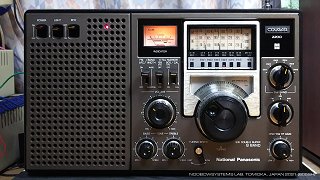
|
National Panasonic RF-2200 "Cougar 2200" Shortwave Receiver
[UPDATED]
Delivering milk bottles everyday for several months allowed me to get this latest,
top-of-the-line shortwave receiver as my own.
The double superhet with 10kHz dial readout was indeed great for an 11 years old kid.
It had, however, a weakness in receiving 7MHz SSB signal.
No matter how it is tuned, only the reverse sideband was heard.
Thus the boy continued to deliver newspapers, to get
Trio TS-820
.
The boy promised to himself - to fix this issue of this radio, someday. 47 years have passed. Now it is time to make his promise fulfilled. |
|

|
Toshiba RP-1500F "TRY X 1500" Shortwave Receiver
[NEW]
This low cost standard 3 band portable was cared well by the previous owner;
cleaned inside and outside, missing battery cover was replaced by handmade one,
and a dial illumination LED was added.
The radio plays well except tone control -
a small circuit board had a crack which prevented the audio signal reacing to the tone control circuit.
Most likely the previous owner bent the board and broke it,
when they attenpted to remove the tone control knob.
|
|

|
Toshiba RP-1600F "TRY X 1600" Shortwave Receiver
[UPDATED]
Low priced entry model covers only up to 12MHz, having no BFO, no
external antenna terminal. Although the built-in "CAL" marker and dial
ring with sub scale of international broadcast bands promised better
frequency readout, it did not appeal well to shortwave fans. This unit
is in poor condition inside and outside, wondering if any effort would
be worth.
|
|

|
Kobe Kogyo "TEN" KT-200 All Wave Transistor Radio
[NEW]
Early All Wave Transistor Radio uses 6 germanium transistors made by Kobe Kogyo,
better known as "Ten".
Coloring scheme is typical one in the late 1950s to early 1960s, but it looks sharp as it does use any gold in color which might make the product "too old". Replacing the electrolythic capacitors brought the radio performing surprizing well, 60+ years old germanium transistors are playing well, shortwave performance is excellent on this "standard 6-TR superhet" curcuit. |
|

|
Sony ICR-4800 Shortwave Receiver
Pocket radio was an indispensable item for outback motorcycling then.
Wake up in a cool dawn, crawl out from the tent, turn on the radio,
boil water for a cup of coffee,
adjust and lublicate drive chain while waiting for a weather forecast on the radio ----
it was such a precious moment and I wonder how long I have been missing such a priceless time.
|
|

|
Design Go KK-939B Shortwave Receiver
Replacement to my trustworthy travel companion ICR-4800 is this low priced,
pocket sized radio with digital readout and built-in alarm clock.
The original version of this radio has a flashy looking, but the version here has a chic color scheme.
The radio, however, suffered a low sensitivity on the first day of its second journy to Europe.
The manufacturer's website states that the radio uses "Advanced SMT technology", but...
|
|

|
ICOM IC-502 50MHz SSB Portable Transceiver
My first radio on the air was an IC-502.
With 3 element yagi mounted on top of the roof,
normally the communication range was less than 30 miles or so.
However once sporadic-E layer forms,
distant stations more than 400 miles could be worked easily and clearly with only 3W of output power and built-in whip antenna.
This is the wonder of Six Meters.
|
|

|
ICOM IC-T31 430MHz FM Handheld Transceiver
Purchased in 1993 to communicate with my teammates when we participate motorsport events,
this radio was rarely used to make normal QSO as FM was not my favorite.
Nevertheless I always took this radio with me and
monitored K6FB repeater every night,
until I bought a new Alinco 2m/70cm dualbander.
|
|
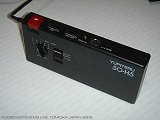
|
Yupiteru 50-H5 Hands-free Communicator
Designed to be a convenient tool for a short-distance hands free communication,
this 50MHz FM transceiver has an output power of only 10mW;
maximum coverage is approx. 500 meters; or 1/4 miles ----
the operation manual has a block diagram and technical information so that
the user can register this radio as an amateur radio transmitter
(Japanese government requests to do so) but I wonder how many of the users,
if anybody, complied to it...
|
|

|
Benmar Navigator NAV-555A Direction Finder
Manufactured by Koden and possibly in cooperation with Bendix,
this civilian marine equipment carried a cheap price tag at a hamfest.
Its BC band sensitivity is so wonderful,
that it could be used for medium wave DXing if selectivity and dial mechanism is improved.
|
|

|
Sony FX-402A TV/Radio Cassette Recorder
Stylish multifunction portable with cassette and monochrome TV,
the radio also coveres shortwave.
After toggling switches for a while to clean their contacts,
all functions including TV revived.
Light maintenance, realignment and cleaning will make this set fully servicable.
|
|

|
Sony CF-1480 "Studio 1480" Cassette Radio Recorder
Yome enjoyed music when she was an elementary school student some decades ago with this clean and user-friendly radio cassette recorder.
Its circular dial has two red LEDs which light when the station is tuned.
This simple idea provides ease and confortable to the tuning operation, making the radio quite enjoyable.
|
|

|
Sony CF-1980 "Studio 1980" Cassette Radio Recorder
It was absolutely at the top of the line, far beyond the reach of 11 years old kid whose family was in economic difficulty.
15 years later a friend of mine gave his 1980 to me, expecting myself as a guy of seeing a value of heritage.
Time flies - more than 30 years passed until I finally started to work on this clean looking cassette corder for full service.
|
|

|
National Panasonic RQ-554 "MAC for BCL" 5 Band Radio Cassette Recorder
[NEW]
|
|

|
Toshiba RT-4800 "Actas 4800" Cassette Radio Recorder
[UPDATED]
Typical Radio Cassette Recorder with 2 way speaker
which is much larger than modern CD Radio combo,
so the sound is very good.
Overhauling the tape mechanism revived nice tape audio quality,
weak operation of the tuning indicator was found to be caused by a
defective PCB pattern.
|
|

|
Aiwa TPR-840 "Stereo 840" Stereo Radio Cassette Recorder
Although its cassette mechanism failed 1 year after purchased in 1979,
TPR-840 is still one of the best friends of mine.
Its sound is very well balanced and relaxing,
it is always a pleasure listening music with this.
|
|

|
Sony CSF-99 "Energy 99" Stereo Radio Cassette Recorder (1981)
Steadly evolving on its way to the distinction, this huge boombox weighs more than 10 kilograms,
claiming one of the heaviest in the SONY's boombox product history.
It did not catch my attention back in its heyday,
as I was a very poor university student and I tried to keep my attention away of any pricy equipments.
Now Pogo enjoys her Android Walkman, and she wanted a powered speaker so that she could enjoy music in the NoobowSystems 2nd lab as well, and this big mountainous boombox was found in the barn --- I forgot it right after I got it from our relative. It must have been stowed there for 5 years or so. The boombox immediate back to life, started to play radio and line-in signals with powerful and nice audio, perfect to Pogo's need. The tape drive is not working which is quite an expected thing; I shall fix it someday. |
|

|
Sony CFD-500 "DoDeCa HORN CD" Stereo CD Radio Cassette Corder (1991)
Soon after purchased at a second hand shop with "junk" tag,
this powerful boombox was put into the storage room because of no use -
both CD and tape broken,
no line input jacks provided, and its sound quality was really disappointing despite of appealing style and its bass-boost provision.
5 years later I was looking for a bedside audio for the newly established 3rd lab,
and I thought this DoDeCa HORN would be the one if its tape mechanism could be fixed.
|
|

|
Aiwa CSD-SR33 "Strasser" Stereo CD Radio Cassette Recorder
The price of this entry CD Radio Cassette Recorder was lower than the Sony DoDeCa Horn CD,
but the Strasser worked fine while the DoDeCa Horn CD didn't.
The sound quality was of the low end model - quite insufficient for rock music,
so I added a line input jack so that it could be used for multimedia presentation with my business laptop.
|
|

|
Sharp QT-C300 "Segno" Stereo CD Radio Cassette Recorder (1991)
The AST logo promised rich bass in this popular class boombox,
and indeed the sound is much much more better than DoDeCa HORN.
Its appearance is not too shiney or too massive or too decorative -
which is also nice to listen relaxing music.
The tape drive revived by simply replacing drive belts. The radio however did not. It only gave intermittent pop noise both on AM and FM. Tracing the circuit revealed that the trouble is lying somewhere in the intermediate frequency amplifier stage which is inside of the Roam BA4237L FM/AM IF System IC. The only way to fix is to replace the BA4237L. |
|

|
Sony CMT-V10 Walkman Dock Audio System (2013)
Pogo has been using this Walkman Dock Audio for 6 years. It has a powered door for CD disk bak on its front panel.
The power door bacame inoperative in 3 years after the purchase, and was fixed with the extended guarantee.
Now the door isn't working again, and the extended guarantee already expired.
The Walkman interface function is now not so required, so almost decided to buy a new desktop audio. Still, at least the CD disk inside of the unit must be extracted. Opened the unit, the reason of inoperative door was obvious - rubber drive belt was missing - perhaps being still somewhere inside the unit. Using a new rubber belt from our lab's stock parts, the power door became operative - a quick fix. I asked Pogo & Yome 400 Yen for part, 5000 yen for technical fee for the repair. And with that money we went to Beef Grill restaulant and enjoyed a dinner - virtually free. |
|

|
Aiwa XR-FD55 MD Audio System
Purchased as a new, this compact audio system worked as a main audio amplifier at workbench for first 5 years,
then as a main amplifier in a living room in the newly built lab for 12 years.
It started to show trouble not powering up, so retired from 24 hours contonuous operation.
During the stay-home Golden Week due to COVID-19 the storage room in the lab was cleaned up and became a workspace for home-office, this AIWA was an candidate for main audio system of the storage room. |
|

|
Kenwood KR-9340 4 Channel Stereo Receiver
This clean and neat audio equipment was born in amid of the 4 channels fever.
Being ready for various 4 channel formats, the latest CD-4 decoder was provided as an extension unit.
The receiver had revived from complete silence, being used several years,
and again was waiting service for a cure of hum.
7 years later hum problem was solved by replacing another electrolytic.
|
|

|
Nikko STA-301 Solid State Stereo Receiver (1971)
One channel ceased operation several months after purchased at a flea market perhaps back in 1996,
my attempt to fix it failed due to insufficient equipments and spare components,
and the lack of my knowledge and experience.
Fixing this dirt cheap stereo receiver had been my open task, for 25 years.
In a mid of the 2nd COVID-19 stay-home golden week,
I eventually started to resume servicing.
|
|

|
Sherwood S-2100 FM Stereo / AM Tuner (1962)
[UPDATED]
|
|

|
RCA Victor Model 56X Superheterodyne Radio Receiver (1946)
[NEW]
|
|

|
General 6S-10 Superheterodyne Radio Receiver (1953)
Typical Japanese home radio back in 1950s.
This superhet with tuning eye has nice wooden case,
contains 5 "ST" style tubes and a tuning eye.
Obviously the radio had experienced at least two times of emitting smoke,
all of the components under the chassis needed to be replaced.
Completely dead receiver came back to life again after the rebuilding.
|
|

|
National DU-440 All Wave Radio Receiver
Received as a gratitude gift from one of my classmates when I was 10 years old -
I used this vacuum tube receiver as a BFO to listen SSB signal with RF-877 which didn't have BFO.
While cleaning this old radio more than 45 years after I got,
I recognized that this is an export version -
50C5 is used as the audio output tube.
If this is a Japanese market version, 35C5 should have been used.
Why my friend had this radio in his home?
It may remain mystery forever.
|
|

|
Several Popular Tabletop Radios
In this page several popular tabletop radios are introduced.
They include Zenith F510F, GE C-43, RCA Victor Model 56X,
GE Model 408 and Japanese government regulated type-2 model manufactured by Ohmori-Seisakusyo.
|